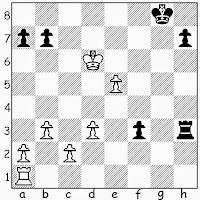The Bishop sacrifice at f7, the Queen checks followed by the capture of Black's Knight - if the following game wasn't inspired by the Jerome Gambit, it should have been. (Of course, Philidor 1792 plays the Jerome Gambit!)
The tactical mayhem at the end is as entertaining as it is bewildering.
Philidor 1792 -guest343
3 0 blitz, www.bereg.ru, 2013
1.e4 Nf6 2.Bc4
Philidor 1792 returns to the Krejcik Gambit in Alekhine's Defense (see an earlier example). As I've mentioned, it's Jerome-ish enough to have been touched on a couple of times earlier in this blog, in "I want my Jerome Gambit!" and "Another Krejcik".
The Krejcik might be a bit unorthodox, but in 3-minute games it can be deadly.
2...Nxe4 3.Bxf7+ Kxf7 4.Qh5+ g6 5.Qd5+ e6 6.Qxe4 Bg7
The position may or may not be balanced - but how much time did each player take to get here?
7.Qf4+ Qf6 8.Qxc7 Nc6 9.Nf3 Rf8
Black prepares to castle-by-hand, an idea always in vogue in Bxf7+ openings, but in doing so he misses the tactical shot 9...Qxf3!?, when 10.gxf3 Be5 would force 11.Qxe5 Nxe5. Either the idea did not appeal to the second player, or he overlooked it. In any event, the opportunity is available for the next 4 moves, as well.
10.O-O Kg8 11.Nc3 d5 12.d3 Qf5 13.Bd2 Ne5
14.Nd4 Qg4 15.f4 Nxd3 16.Nxe6 Bxe6 17.cxd3 Bd4+ 18.Kh1 Rf5
Black adds a Rook to the aggressive actions of his Queen and two Bishops, so his intentions are clear. He is even willing to let White snipe another pawn, in order to get the other Rook into play.
19.Qxb7 Raf8 20.Rae1
Houdini prefers 20.Qb4, as the start of a difficult defense that eventually sees White trade off a lot of the attacking pieces, keeping a pawn advantage. Philidor 1792's move is more "human" and keeps the game in balance.
20...Rh5
21.Rf3
Houdini also suggests 21.Qe7, "forcing" Black (i.e. the best response it sees) to sacrifice a Rook to obtain a draw, with 21...Rxh7+ 22.Kxh7 Qh5+ 23.Kg3 Qg4+, etc. - but who plays chess like that? Neither player is thinking "draw" at this point.
21...Qh4
Of course, the draw is still there with 21...Rxh2+ 22.Kxh2 Qh4+ 23.Rh3 Bxh3 24.gxh3 Qf2+ 25.Kh1 Qf3+, etc.
22.h3
The only move, says Houdini, to avoid checkmate in 32. How annoying!
22...Rhf5
Black cannot find the best continuation - no doubt, time was short and getting shorter - lets slip a piece, and with it the game. What was there was 22...Bg4!?, although White can afford to give up the exchange with 23.Ref1, when 23...Bxf3 24.Rxf3 still leaves Black searching for a way to break through.
23.Rxe6 g5 24.Nxd5 g4 25. Ne7+ Kh8 26.Nxf5 gxf3 27.Nxh4 f2 28.Re1
Fun!
28...Rxf4
Fighting to the end!
29.Qb8+ Black resigned, as mate is unavoidable.
Well played, gentlemen!



















































